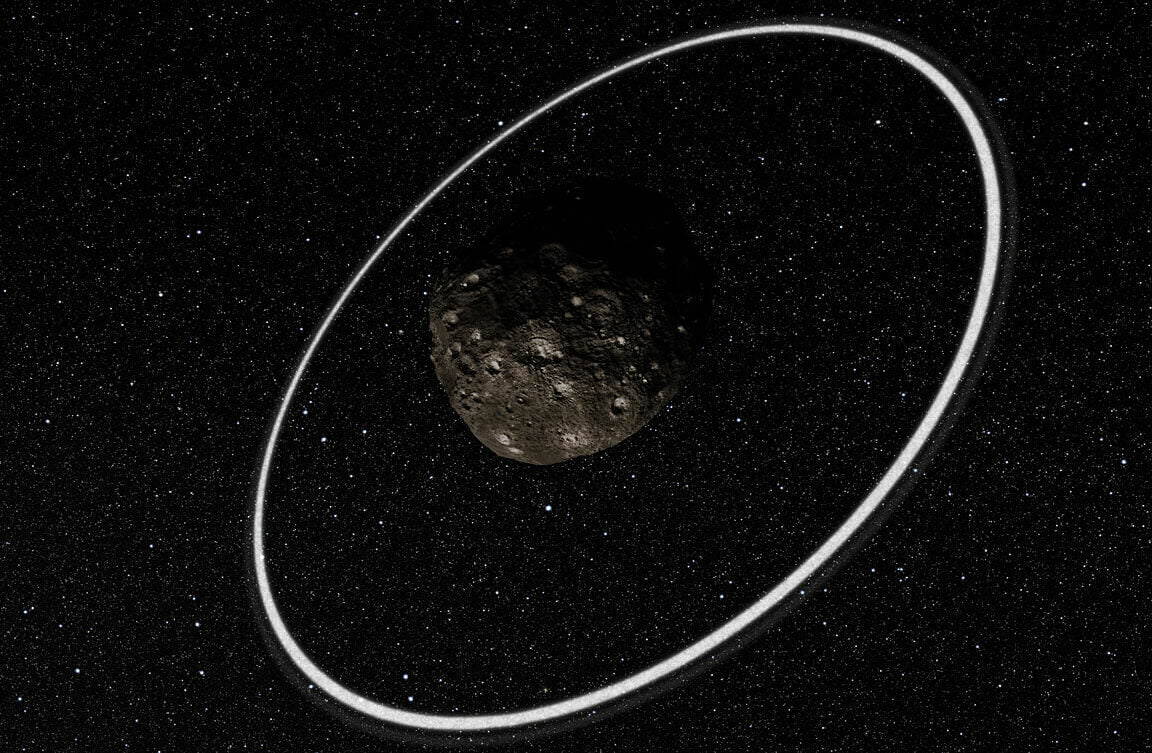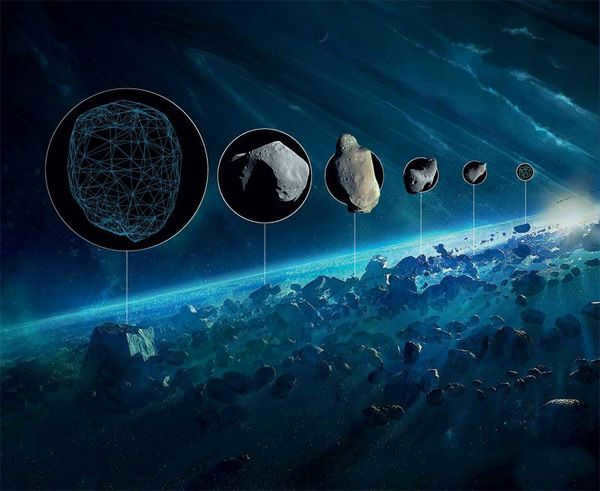
Piazzi was unable to gather sufficient data to compute the orbit of the purported planet, which had disappeared from the European sky by the autumn of 1801. Nonetheless, Bode’s remark inspired the renowned mathematician Carl Friedrich Gauss to develop a calculation method that required less observational data than the prevailing techniques. Gauss sent his findings to von Zach, who utilized them to rediscover the elusive object on January 1, 1802, exactly one year after Piazzi’s initial discovery. On that same night, another member of the “celestial police,” Heinrich Olbers, also observed the celestial body. At Piazzi’s behest, the newly found celestial entity was named after Ceres, the Roman goddess of fertility and the patroness of Sicily.
“Similar to the stars.” The initial theory regarding the source of the recently found celestial bodies
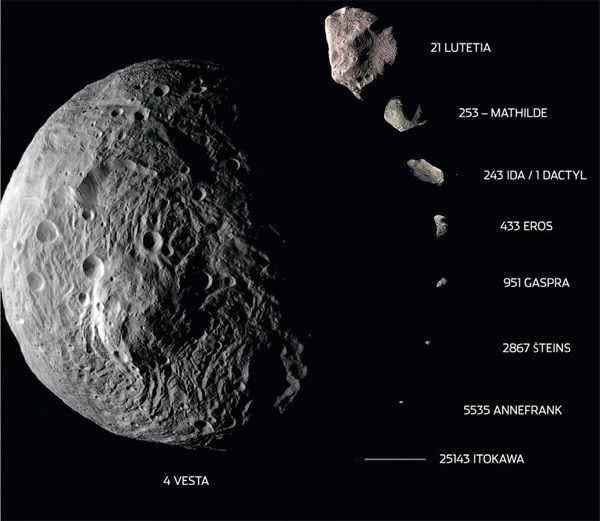
Olbers continued his observations of Ceres, and on March 28, 1802, he noticed another moving object nearby. This object was named Pallas, after the Greek goddess of wisdom. When Gauss calculated the elements of Pallas’ orbit, it became clear that Olbers had been incredibly fortunate. Pallas orbits the Sun in nearly the same amount of time as Ceres (4.6 Earth years), but its path is tilted at an angle of 34 degrees to the ecliptic plane. If Pallas had not been in the vicinity of Ceres during Olbers’ observations, it would not have been discovered until many decades later. Within five years, two more objects like this were found. However, after that, the search for these celestial bodies fell apart. Olbers continued his search for a longer time than others, but he too gave up hunting for asteroids in 1816. The search only resumed in the middle of the 19th century, long after the original discoverers had passed away.
Season for hunting
In 1830, Friedrich Wilhelm Bessel, a mathematician and astronomer, called upon German observatories to commence sky mapping as a means to locate asteroids. While some progress was made in this endeavor, it was actually an amateur, postmaster Karl Henke, who made the first discovery. After 15 years of unsuccessful observations, Henke stumbled upon the fifth asteroid, Astrea, on December 8, 1845. Henke went on to spot asteroid number 6, known as Geba, in 1847, while the young English astronomer John Russell Hinde discovered the asteroids Iris and Flora shortly thereafter. This marked the beginning of a rapid acceleration in the search for minor planets. Christian Peters, the first American asteroid hunter, discovered 48 asteroids between 1861 and 1889, while German astronomer Carl Luther found 24. By 1890, astronomical catalogs contained approximately three hundred celestial bodies residing in the region between Mars and Jupiter.
And so began a new era. Maximilian Wolf, a Private Associate Professor at the University of Heidelberg, became the pioneer in utilizing photography to hunt for minor planets. In December 1891, he made his inaugural asteroid discovery, and within the subsequent year, he found an additional 13. By 1902, Wolf assumed leadership of the newly established university observatory, transforming it into the global hub for “minor planetology”. His junior colleague, Carl Reinmuth, set an unmatched record between 1912 and 1957 by discovering 389 asteroids, a feat that remains unchallenged.
During the time span between the first and second global conflicts, there was a great deal of effort put into the exploration and detection of asteroids. This period, specifically the 1930s, saw the identification of nearly four hundred new asteroids. However, progress in this field significantly slowed down for three decades following that period. The revitalization of asteroid research came about with the advancement of technology, such as the incorporation of semiconductor photometers and other electronic devices into telescopes. Additionally, the emergence of powerful computers capable of swiftly computing asteroid trajectories played a crucial role in this revival. More recently, the study of minor planets has been expanded through the utilization of ground-based robotic telescopes, orbital observatories, and deep space probes.
Main asteroid belt
The majority of asteroids in our solar system are concentrated within a region known as the main asteroid belt. This belt, which can be visualized as a ring or bagel-shaped zone, spans from a distance of two astronomical units from the Sun to three and a half astronomical units. While most asteroids are confined to this region, some of their paths extend beyond the plane of the ecliptic. Within the main asteroid belt, there are approximately two hundred small planets with average diameters exceeding 100 kilometers. It is estimated that there are between 1 to 2 million asteroids at least one kilometer in size. Despite this large number, the combined mass of all the asteroids in the main belt is about 25 times less than that of the Moon!
Asteroid paths
The paths taken by near-Earth asteroids exhibit a wide range of diversity: some orbit back to the main belt and may even venture much farther, while others consistently remain in close proximity to the Sun. There are even asteroids that boldly venture closer to the Sun than Mercury.
The distribution of asteroid trajectories in the main belt is not uniform. In the 1860s, Professor Daniel Kirkwood of Indiana University discovered gaps in these trajectories. After studying the paths of 97 asteroids, Kirkwood found that these bodies avoid orbits with periods that are related to the period of Jupiter (for example, if the periods are in a 1:3 ratio). Kirkwood also realized that this avoidance is due to the fact that these bodies periodically come close to Jupiter on the same part of their trajectory, causing their paths to deviate under the influence of Jupiter’s gravity (this phenomenon, first observed by Laplace in the early 19th century with Jupiter’s satellites, is known as orbital resonance). In the main belt, there are Kirkwood gaps (also known as hatches in Russian literature) and other resonances such as 1:2, 2:5, 3:5, and 3:7.
Additionally, at least one third of the asteroids in the main belt form families with similar orbital elements, such as the length of the major semi-major axis, eccentricity, and inclination of the orbit to the ecliptic plane. The first of these families was identified nearly a hundred years ago by Professor Kiyotsugu Hirayama of the University of Tokyo. Hirayama believed that each family consisted of fragments from a larger asteroid that had broken apart due to a collision with a smaller body, and this explanation is still considered the most plausible.
It is a certainty that asteroids in the main belt will collide at present (although we have not yet been able to witness it firsthand), but collisions were a frequent occurrence in the past. Many, if not all, asteroids are fragments of their predecessors. This is the reason why there are not many asteroids in the belt that possess their own satellites. As stated by Clark Chapman, a senior scientist at the Southwest Research Institute in Colorado, their proportion does not exceed 15% (in contrast to 75% of the planets). It is likely that asteroids lose their moons not only through direct impacts, but also due to gravitational disturbances caused by the presence of neighboring asteroids. The random distribution of rotation axes among asteroids is also a consequence of collisions. Only Ceres, Pallada, and Vesta have a consistent rotation inherited from the primary preplanetary swarm from which both asteroids and planets originated. They have maintained this rotation due to their substantial mass, which provides them with a significant angular momentum.
Trojan asteroids
In the 19th century, the majority of asteroids that were identified were found to be located within the main belt. However, two outliers, Ephra and Eros, were observed to cross the orbit of Mars, making them unique. No other instances of asteroids breaking free from the main belt were reported during this period.
In the 20th century, there were significant changes in this area as well. On February 23, 1906, Wolf took a photograph of a faint asteroid that was moving in an orbit almost identical to Jupiter’s, positioned 55.5 degrees ahead of the planet. This asteroid was later named Achilles and assigned the number 588. Swedish astronomer Carl Charlier soon realized that Achilles was in motion around one of the stable libration points predicted by Joseph Louis Lagrange in 1772. Achilles periodically comes close to the L4 libration point, which is located 60 degrees ahead of Jupiter. Later on, another asteroid named Patroclus was discovered at this point, and Hector was discovered near the L5 point, 60 degrees behind the planet. It became a tradition to name these asteroids after the heroes of the Trojan War. Those near the L4 libration point were named after the Achaeans, such as Achilles, Nestor, Agamemnon, Odysseus, Ajax, Diomedes, Antilochus, and Menelaus. Those near the L5 libration point were named after the defenders of Troy, including Priam, Aeneas, and Antiphus. However, this tradition did not emerge immediately, which is why Hector and Patroclus ended up in the “enemy camps”.
So far, there have been approximately 5000 Trojans found in close proximity to Jupiter. The angular separation between these Trojans and Jupiter can vary greatly, ranging from 45 to 100 degrees. Additionally, there are four Trojans located near Mars, and eight in the orbital region of Neptune. In July of 2011, Canadian astronomers identified the initial potential companion Trojan for our planet. This particular Trojan is a three-hundred-meter asteroid named 2010 TK7, and it was discovered using the WISE infrared telescope. The WISE telescope operated in Earth’s orbit from January to October 2010.
Near-Earth asteroids
In the spring of 1932, a new wave of asteroid discoveries began. Eugène Delporte, a Belgian astronomer, made a significant finding on March 12 when he spotted the asteroid Amur. This particular asteroid has a perihelion distance of 1.08 astronomical units, bringing it remarkably close to the outer edge of Earth’s orbit. Just six weeks later, Carl Reinmuth also made an important discovery. He found the asteroid Apollo, which has an orbit that intersects with both Earth’s and Venusian’s orbits. In fact, Apollo’s perihelion distance from the Sun is a mere 0.65 astronomical units.
Cupid and Apollo were the ancestors of two groups of celestial bodies that traverse the inner reaches of the solar system. They are collectively known as Near-Earth Asteroids (NEAs). Amor-type asteroids have a perihelion range of 1.3 a.u. to the Earth’s orbit maximum radius of 1.017 a.u. Apollo-type asteroids, on the other hand, have a perihelion less than 1.017 a.u. and a major semi-axis greater than 1 a.u. There is also another group of near-Earth asteroids with a major semi-axis length of less than one astronomical unit. About 50% of these asteroids, the first of which was discovered in 1976 and named after the Egyptian god Aton, are still further away from the Sun than the Earth due to their elliptical orbits with high eccentricity. Among these asteroids, there is a subfamily known as atons, whose apogee is less than the Earth’s orbit minimum radius of 0.983 a.u. These celestial bodies are always closer to the Sun than our planet.
The orbits of near-Earth asteroids exhibit a great deal of variation. Some of these asteroids follow a periodic pattern, returning to the main asteroid belt and occasionally venturing even farther, while others consistently maintain their proximity to the Sun. Take, for instance, asteroid 1685 Thoro, which has a maximum distance from the Sun (apogee) of 1.96 astronomical units (a.u.) and a minimum distance (perihelion) of 0.77 a.u. This asteroid traverses the orbits of both Earth and Mars, and it is a mere 0.05 a.u. away from reaching the orbit of Venus. Thoro completes five revolutions around the Sun in a span of 8 Earth years and 13 Venusian years, indicating that it is in a state of orbital resonance with both of these planets. In fact, there are even asteroids that dare to approach the Sun more closely than Mercury itself. A prime example is asteroid 1566 Icarus, which belongs to the Apollo family and was first identified by American astronomer Walter Baade in 1949.
Unfinished worlds
Asteroids can be considered as unfinished worlds. They were both created through the collision and merging of planetesimals, solid bodies of various sizes that once orbited around the young Sun. These planetesimals were formed by the accumulation of particles from the original gas-dust cloud that gave birth to our solar system. However, in the region beyond Mars’ orbit, these planetesimals failed to coalesce into a larger planet. This was most likely due to gravitational disturbances caused by Jupiter, although other factors may have been at play. It is possible that Jupiter, on multiple occasions, expelled large bodies towards the Sun, further destabilizing the asteroid belt.
The initial asteroids, originating from planesimals, originally orbited in the ecliptic plane with nearly circular paths and low relative speeds. This prevented them from breaking apart upon collision and instead allowed them to merge and expand. However, the gravitational pull of Jupiter gradually influenced the asteroids to shift towards inclined paths with greater eccentricity, resulting in an increase in their relative velocity to 5 km/s (which is the current rate). When colliding at this accelerated speed, the asteroids shattered into fragments that were unable to form a complete planet.
Asteroid Classifications
The information regarding the structure of asteroids is gathered through spectral analysis of the sunlight that is reflected by them and is further adjusted by geochemical data on the composition of meteorites, as asteroids serve as the main source for meteorites. Based on this criteria, asteroids are classified into three categories: C (high-carbon bodies), S (silicates with a proportion of metals), and M (iron-nickel). The majority of asteroids in the main belt fall under the C class, accounting for 75% of them, while S class asteroids make up 17% of the total. However, more detailed classifications exist with a larger number of groups. All asteroids, without exception, undergo rotation, and the orientation of their axes in space is generally random. Typically, asteroidal days last between 6 to 13 hours, although there are exceptions. For instance, a small asteroid called 1998 KY26 that measures approximately 30 meters in diameter completes a full rotation in just 10 minutes and 42 seconds. This high angular velocity is most likely a result of interactions with its closest counterparts.
These processes have had a dramatic impact on the asteroid belt. While the exact initial mass is unknown, model calculations suggest it could have been around 2200 times larger than it is today, roughly equivalent to the mass of Earth. These calculations also indicate that there were numerous bodies of similar mass and size to Ceres. However, through a series of collisions, these bodies were destroyed and their fragments were ejected from the belt, causing it to thin out significantly. As a result, collisions within the belt have become rare and the surviving asteroids now follow relatively stable paths. Thus, the current asteroid belt is a mere shadow of its former grandeur.
Clark Chapman observed that, as per several planetologists, there could have existed a former belt amidst Earth and Venus. Nevertheless, these asteroids encountered significantly greater challenges in their survival. It can be postulated that nearly all of them disintegrated following collisions, and their fragments were propelled away from the Sun.
The Rise of Iron-Nickel Fever
Speculative fiction authors have long envisioned the future potential of asteroids in terms of national and economic progress – one need only recall Asimov’s tale, “The Path of the Martians”. This notion is not unfounded. Within the asteroid belt lies vast reservoirs of pristine water ice and a diverse array of minerals. Just one cubic kilometer of a typical M-class asteroid contains an astounding 7 billion tons of iron, 1 billion tons of nickel, and millions of tons of cobalt. The combined worth of these metals, at current market prices, is an astronomical $5 trillion. It is our fervent hope that if humanity ever gains access to these resources, they will be utilized judiciously and to great advantage.
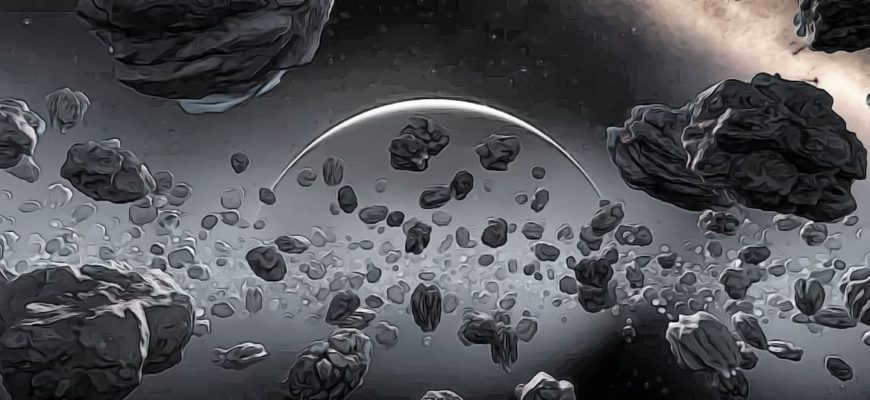
There is a belief among certain individuals that there ought to exist an additional planet located between Mars and Jupiter. These individuals also highlight the fact that instead of a planet, there exists an asteroid belt in this particular region of outer space. However, the question that arises is whether these assertions hold any truth. In order to find the answer to this inquiry, we must embark on a journey through time by means of a spacecraft and travel back to the very inception of our solar system.
The emergence of the sun
Let’s rewind the timer on our time machine by 4.6 billion years and journey back to a time when the solar system had not yet come into existence. Picture ourselves aboard our spacecraft, navigating through the Orion arm of the Milky Way, which is now our galactic abode. However, during that era, the sun and planets had yet to materialize. Instead, if we peer through the spaceship’s porthole, we are greeted by the vast emptiness of space.
Yet, this apparent void is far from barren. It holds a colossal cloud composed of gas and dust, remnants of a stellar explosion.
And right before our very eyes, a new star is on the brink of birth!
We adjust the settings on our time machine to transport us one million years into the future in just one second. After preparing some tea and stirring in the sugar, we make our way to the expansive panoramic window. From there, we observe the formation of a cloud composed of gas and dust. Initially, the cloud rotates at a slow pace, resembling the movements of a figure skater with outstretched arms. However, as it continues to rotate, its speed gradually intensifies, mimicking the skater’s increased velocity when bringing their arms closer to their body. You can try this experiment at home, substituting skates for a swivel chair.
Over time, the cloud begins to transform into a disk shape. Its center becomes increasingly compact, as the gravitational forces cause it to heat up. The temperature rises significantly, reaching a few thousand degrees. Then, at last, the first hydrogen atoms merge together in a magnificent display of universal joy. An explosion occurs, accompanied by fire and the release of tremendous amounts of energy.
And thus, a new star is born! This radiant entity is our very own Sun, just beginning its journey through the cosmos.
The Sun is composed of a significant amount of gas and dust that was captured from the original cloud. However, some of the cloud’s material remains outside the young star, still spinning rapidly around the Sun.
The formation of planets
Over time, these gas and dust particles begin to collide and merge together. Initially, they form small lumps, which then grow into pebble-sized objects, then rocks, boulders, and eventually, miniature planets. Eventually, they develop into fully formed planets.
Observing this phenomenon from our spacecraft is truly a magnificent sight. We witness the momentous collisions of these planetoids, resembling solid rocks, as they collide and shatter into one another. Over time, these spectacular collisions result in the creation of the familiar planets we recognize today, each formed from countless minuscule particles of dust. Here they are, ranging from the scorching proximity of Mercury to the frigid outskirts of the solar system, where Neptune lurks.
Nevertheless, the tale does not conclude here.
The belt of celestial debris
Despite the birth of all the planets, there remains a collection of celestial debris in the solar system that is often overlooked. This assortment of material failed to integrate into the formation of the planets and instead exists as a group of abandoned rocks known as asteroids. Comprised mainly of rocky minerals and metals, such as iron and nickel, these asteroids range in size from a few meters to over 900 kilometers in diameter. To put this into perspective, that’s roughly the distance between Moscow and Volgograd.
All of these celestial bodies revolve around the newly formed Sun. There are various asteroids scattered throughout the entire solar system. However, the majority of them are positioned in a circular formation between the planets Mars and Jupiter. The reason for this is the immense size of Jupiter, which exerts a significant gravitational force on all other objects in the solar system. Essentially, Jupiter functions as a colossal cosmic vacuum cleaner, directing and gathering all of the idle asteroids into what is commonly known as the asteroid belt. This process holds great significance for sustaining life on Earth since it guarantees that no stray rocks will venture into the inner regions of the solar system, potentially causing catastrophic events similar to the one that wiped out the dinosaurs 65 million years ago. Jupiter acts as our guardian, dutifully fulfilling its role.
Unlikely to be Phaeton
Previously, astronomers believed that the asteroid belt was once a planet called Phaeton that fragmented for unknown reasons. However, further examination revealed that the amount of material in the asteroid belt is insufficient to support this theory.
While there are some larger objects present, such as Ceres, its mass only accounts for one third of the total mass of the asteroid belt. In fact, astronomers have recently reclassified Ceres as a “dwarf planet” rather than an asteroid.
Considering all the asteroids in the belt, including Ceres, their combined mass would still result in a planet smaller than the Moon. It is well known that the Moon is only a quarter of the size of Earth, making the existence of the planet Phaeton highly unlikely.
According to astronomers, the asteroid belt is no longer considered a planet that has been destroyed. Instead, they now believe that the asteroid belt formed in the same way as observed from our time-traveling spaceship.
If you look up into the night sky with binoculars or a telescope, you can spot large asteroids such as Ceres, Pallada, Vesta, and Juno if you know their locations.
Can you imagine a future where we can actually walk on the surface of these asteroids?
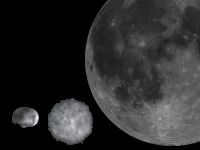
An asteroid is a small celestial body in the solar system that orbits the Sun. These objects, sometimes referred to as small planets, are significantly smaller in size compared to actual planets.
Meanings
The term asteroid was coined by William Herschel to describe objects that resembled stars when viewed through a telescope, as opposed to planets, which appear as disks. The precise definition of an asteroid is still uncertain. The term “minor planet” or “planetoid” is not sufficient for classifying asteroids, as it also denotes their location in the solar system. However, it should be noted that not all asteroids are considered minor planets.
One method of categorizing asteroids involves determining their size. The current system of classification defines asteroids as celestial bodies with diameters exceeding 50 meters, distinguishing them from meteoroids which resemble sizable rocks or may even be smaller. This classification is based on the premise that asteroids are capable of surviving re-entry into the Earth’s atmosphere and making contact with its surface, whereas meteoroids typically burn up entirely upon entering the atmosphere.
Consequently, an “asteroid” can be defined as a solid object within the solar system that is larger than a meteoroid.
The Solar System’s Asteroids
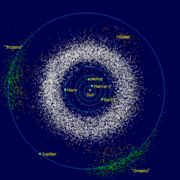
To date, the Solar System has witnessed the discovery of tens of thousands of asteroids. According to the databases, as of September 26, 2006, there were 385,083 objects recorded, out of which 164,612 had accurately determined orbits and were assigned an official number [1]. At that time, 14,077 of these objects had names officially approved [2]. It is estimated that the solar system may harbor between 1.1 and 1.9 million objects larger than 1 kilometer [3]. The majority of the currently known asteroids can be found within the asteroid belt, which lies between the orbits of Mars and Jupiter.
The largest asteroid in our Solar System, Ceres, used to be considered as such, measuring approximately 975×909 km. However, it has been reclassified as a dwarf planet since August 24, 2006. The other two significant asteroids, 2 Pallada and 4 Vesta, have diameters of around 500 km each. Out of these, 4 Vesta is the only asteroid within the asteroid belt that can be seen with the naked eye. Moreover, asteroids following different orbits can also be observed when they pass close to Earth, such as the case of 99942 Apophis.
The combined mass of all the asteroids in the main asteroid belt is estimated to be between 3.0-3.6×10 21 kg, which accounts for only about 4% of the Moon’s total mass. Ceres itself has a mass of 0.95×10 21 kg, making up approximately 32% of the total mass of all asteroids. When considering the three largest asteroids, 4 Vesta (9%), 2 Pallada (7%), and 10 Hygeia (3%), their combined mass reaches 51%, indicating that the majority of asteroids have a negligible mass.
Exploration of Asteroids
The exploration of asteroids commenced subsequent to the detection of the planet Uranus by William Herschel in 1781. Its average distance from the sun was determined to be in accordance with the Titius-Bode rule.
In the late 1700s, Franz Xaver von Zach formed a team of 24 astronomers. Starting in 1789, this team embarked on a mission to locate a planet that, according to the Titius-Bode rule, was predicted to be situated approximately 2.8 astronomical units away from the Sun – between the orbits of Mars and Jupiter. Their objective was to record the coordinates of all stars within the zodiacal constellations at a specific moment in time. In the following nights, the team would verify the coordinates and highlight any objects that had noticeably shifted. The expected displacement of the sought-after planet was estimated to be around 30 angular seconds per hour, making it relatively easy to identify.
Interestingly, the initial asteroid, 1 Ceres, was stumbled upon by chance by an Italian astronomer named Piazzi in 1801, on the very first night of the 19th century. In the following years, three more asteroids, namely 2 Pallada, 3 Juno, and 4 Vesta, were detected. The last one, Vesta, was found in 1807. Despite 8 years of unsuccessful searching, most astronomers concluded that there were no more asteroids to be found and halted their research.
However, Carl Ludwig Henke persevered and in 1830 he decided to resume his quest for new asteroids. Just five years later, he discovered Astrea, marking the first new asteroid discovery in 38 years. Less than two years after that, he also came across Geba. This prompted other astronomers to join the search, and from then on, at least one new asteroid was discovered each year (except in 1945).
In 1891, Max Wolf revolutionized the search for asteroids by introducing astrophotography. By capturing photographs with extended exposure times, Wolf was able to detect asteroids as short, bright lines. This groundbreaking method significantly increased the number of asteroid discoveries compared to previous visual observation techniques. Wolf’s remarkable efforts led to the discovery of 248 asteroids, beginning with 323 Brutii, surpassing the mere 300 that had been identified prior to his work. Fast forward a century, and only a small fraction of the thousands of asteroids known today have been officially named and numbered. Despite their abundance, scientists have not prioritized the study of these celestial objects, often referring to them as the “vermin of the skies.”
Asteroid Naming
Initially, asteroids were named after legendary figures from Roman and Greek mythology. However, as time went on, the discoverers were granted the privilege to assign any name they desired, including their own. Originally, female names were predominantly given to asteroids, with male names reserved for those with unique orbits, such as Icarus, which is closer to the Sun than Mercury. However, this practice eventually ceased to be followed.
Not every asteroid is eligible for a name, only those with a relatively accurate calculated orbit. There have been instances where an asteroid receives a name decades after its discovery. Prior to the orbit calculation, an asteroid is given a serial number that reflects the date of discovery, such as 1950 DA. The numbers indicate the year, while the first letter indicates the crescent number in which the asteroid was found (in the given example, it is the second half of February). The second letter represents the serial number of the asteroid within that crescent, with our example being the first asteroid discovered. As there are 24 crescents and 26 English letters, the designations do not include the letters I (due to its similarity to a unit) and Z. If the number of asteroids discovered during a crescent exceeds 24, the alphabet is looped back to assign the second letter an index of 2, 3 on the next loop, and so on.
When an asteroid is given an official name, it is assigned a number (in ordinal form) and a name, such as 1 Ceres or 8 Flora.
Asteroid Classification
Asteroids are generally classified based on their orbital characteristics and the description of the visible spectrum of sunlight reflected by their surfaces.
Orbital groups and families
Asteroids are categorized into groups and families based on the orbital characteristics they exhibit. Groups are typically named after the initial asteroid that was identified within a specific orbit. These groups are relatively loosely organized. In contrast, families are more tightly knit formations that originated in the past when significant asteroids were shattered due to collisions with other celestial bodies.
Spectral categories
In 1975, a system was developed by Clark R. Chapman, David Morrison, and Ben Zellner to classify asteroids based on their color, albedo, and spectral characteristics. [5] Originally, this classification consisted of just three categories: [6]
- Category C – Carbonaceous, representing 75% of known asteroids.
- Category S – Silicate, representing 17% of known asteroids.
- Category M – Metallic, representing the majority of the remaining asteroids.
Over time, this list has been expanded and the number of categories continues to increase as more asteroids are studied in depth:
It should be noted that the number of known asteroids assigned to each category may not be entirely accurate. Some categories are challenging to determine, and the classification of a specific asteroid may be revised with more thorough investigations.
Challenges in the Field of Spectral Classification
In the beginning, the classification of asteroids was primarily reliant on three distinct types of materials found within them:
Nevertheless, there exists skepticism regarding whether such a classification truly provides an unequivocal determination of an asteroid’s composition. Although asteroids of different spectral classes do indicate varying compositions, there is no concrete evidence to suggest that asteroids within the same spectral class are necessarily composed of the same materials. Consequently, scientists have not embraced this new system, leading to a halt in the implementation of spectral classification.
The initial 30 asteroids
Observations
- ↑Minor Planet Statistics. Verified on October 17, 2007.
- ↑Minor Planet Names. Verified on October 17, 2007.
- ↑New research reveals twice the number of asteroids than previously estimated. Verified on March 28, 2006.
- ↑ Krasinsky, G. A.; Pitjeva, E. V.; Vasilyev, M. V.; Yagudina, E. I. (July 2002). "Undiscovered Mass in the Asteroid Belt". Icarus158 (1): 98-105. DOI:10.1006/icar.2002.6837.
- ↑ Chapman, C. R., Morrison, D., & Zellner, B. (1975). "Surface characteristics of asteroids: A combination of polarimetry, radiometry, and spectrophotometry". Icarus25: 104-130.
- ↑McSween Jr., Harry Y. Meteorites and Their Parent Planets. – ISBN 0-521-58751-4
References
Additional Resources
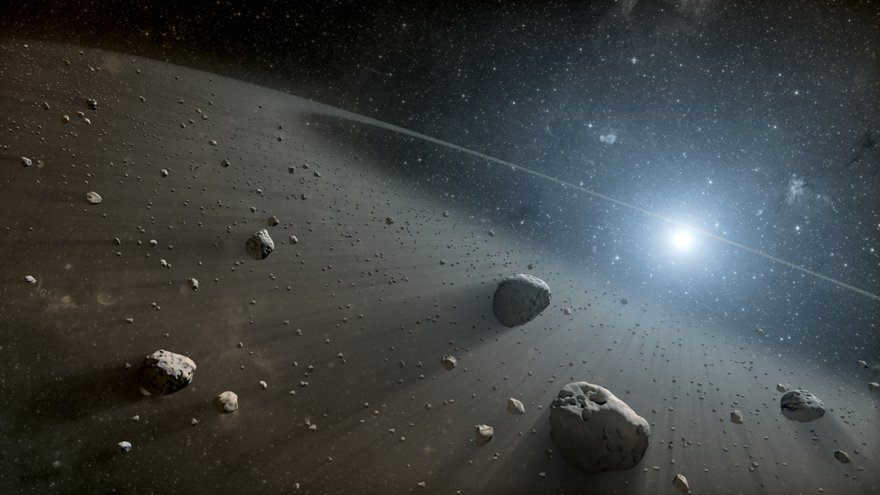
During the 18th century, scientists were able to create a basic map of our solar system by observing the paths of the planets in their orbits. This research led to the development of the Titius-Bode law, which predicted the gaps between the planets. One significant gap that stood out was the space between Mars and Jupiter, which caught the attention of researchers.
Furthermore, small celestial bodies, later named “asteroids”, were discovered within these gaps and eventually formed what is now known as the asteroid belt. Let’s take a closer look at the main asteroid belt in our solar system.
The Origins of the Asteroid Belt
In the year 1800, Franz Xaver von Zack devised a plan to address the enigma of the Titius-Bode law. To aid in his investigation, he assembled a group of astronomers known as the United Space Community, which boasted the esteemed presence of William Herschel.
Remarkably, it was not a member of the club who made the initial discovery. On January 1, 1801, Giuseppe Piazzi, though not yet an official member of the United Space Community, spotted the first minuscule celestial body. This unexpected finding would prove to be the catalyst for the exploration of the vast expanse now known as the Asteroid Belt.
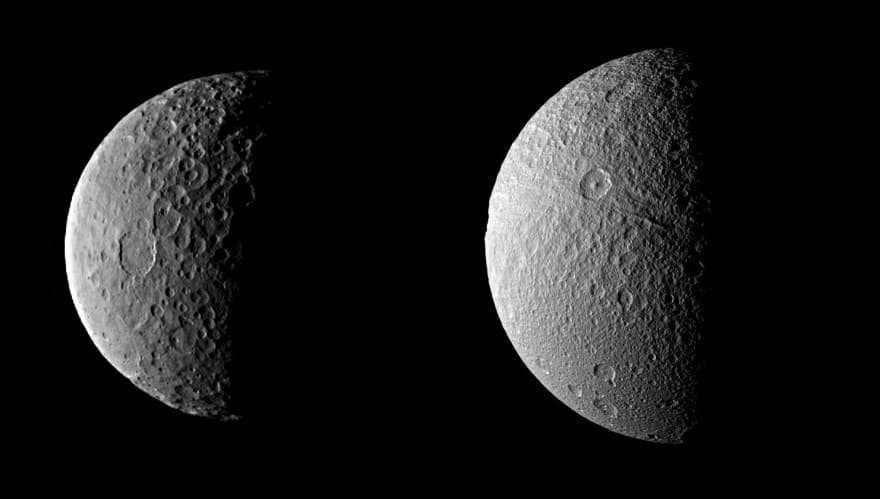
A comparison of Ceres (left) and Tephyus (right)
Initially, it was believed to be a comet, but it soon became evident that it lacked a coma. It was given the name Ceres (pictured above), and it was initially believed to be a planet. Around fifteen months later, another celestial body was discovered in the same region – 2 Pallada.
In terms of appearance, these objects bore a striking resemblance to stars, as even when viewed at the highest magnification, they did not appear as discs. However, their rapid movement indicated that they were in orbit. William Herschel proposed the classification of these objects as “asteroids”.
In 1807, the discovery of 3 Juno and 4 Vesta took place, followed by the finding of 5 Astrea in 1845. During the 1850s, the term “asteroids” started to gain popularity as more and more objects were being discovered. The concept of an asteroid belt began to emerge, although the exact origin of it remained unknown. The diagram below illustrates the orbit of the asteroid belt located between Mars and Jupiter.
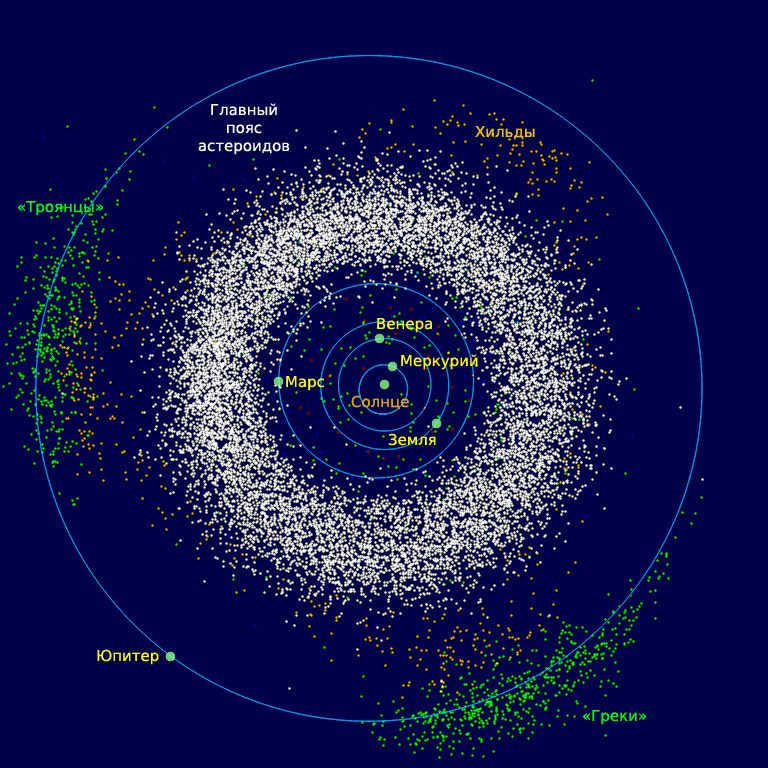

Asteroids of the inner system and Jupiter: a torus-shaped asteroid belt is situated between the orbits of Jupiter and Mars
In 1868, a catalogue of 100 asteroids was compiled, and the introduction of photography in 1891 enabled a significant increase in the number of discoveries. By 1921, 1000 objects had been identified, followed by 10,000 in 1981 and 100,000 in 2000. Modern systems employ automated search programs.
Structure of the Asteroid Belt
Contrary to popular belief, the primary asteroid belt is largely an expanse of emptiness, with objects scattered sparsely over vast distances. However, we are aware of the existence of hundreds of thousands of asteroids, with the total count possibly reaching one million. Among these, around 200 objects have a diameter of 100 km, and surveys using infrared technology have revealed the presence of 0.7-1.7 million asteroids measuring 1 km or larger in size.
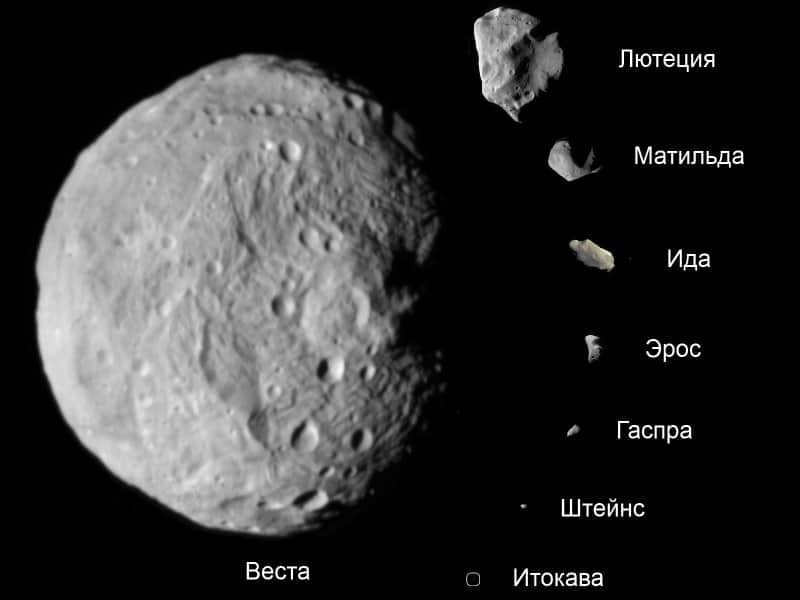
Comparison of sizes among several asteroids in the main asteroid belt
The asteroid belt is positioned between Mars and Jupiter, approximately 2.2-3.2 astronomical units away from the Sun, and spans a distance of 1 astronomical unit. The cumulative mass ranges from 2.8 x 10^21 kg to 3.2 x 10^21 kg, which is equivalent to 4% of the Moon’s mass. The four largest objects, namely Ceres (1/3), 4 Vesta, 2 Pallada, and 10 Hygeia, account for approximately half of the total mass.
The main population of the asteroid belt is often categorized into three zones based on the Kirkwood Gap, which was named after Daniel Kirkwood. In 1866, Kirkwood discovered gaps between the orbital paths of asteroids.
Zone I is situated between the 4:1 resonances and the 3:1 gaps identified by Kirkwood, which corresponds to a distance of 2.6 a.u. and 2.5 a.u. from the Sun. Zone II extends from the end of Zone I to the 5:2 resonance gap at 2.88 a.u. Zone III spans from the outer edge of Zone II to a 2:1 gap at 3.28 a.u.
The primary asteroid belt, located between the planets, is also divided into an inner and outer region. The inner region consists of asteroids that are closer to Mars, while the outer region is closer to Jupiter’s orbital path. The inner boundary of the belt can be defined as asteroids with a distance of 2.06 a.u. from the Sun.
The temperature within the belt varies depending on the distance from the Sun. For particles in the inner region, the temperature is approximately -73°C at a distance of 2.2 a.u. and -108°C at 3.2 a.u.
Makeup of the Asteroid Belt
The Asteroid Belt is made up of a variety of materials, with many asteroids consisting primarily of rocky substances. However, there are also asteroids that contain high concentrations of iron and nickel. Additionally, some asteroids in the belt have impurities of carbon, ice, and other volatiles.
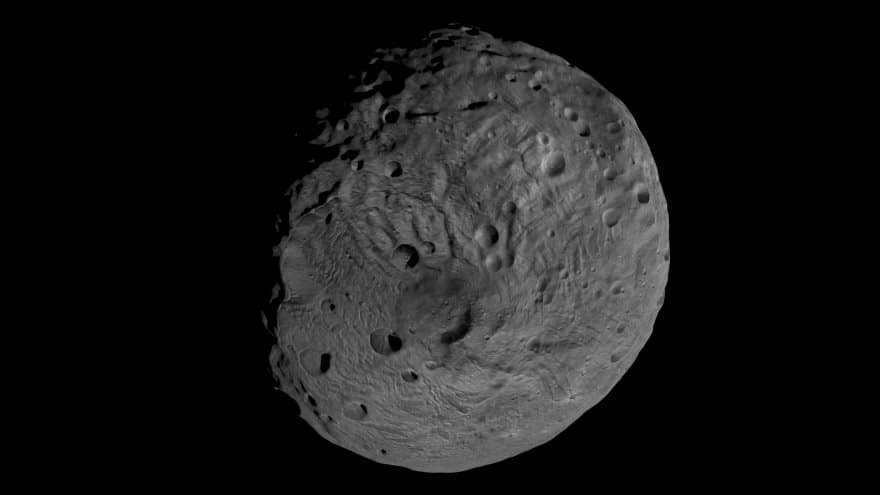
An image of the asteroid Vesta was captured by the Dawn spacecraft during a close flyby in 2011.
The asteroid belt contains three main types of asteroids: C (carbonaceous), S (silicate), and M (metallic). The C-type asteroids are rich in carbon and are mostly found in the outer regions of the belt, accounting for more than 75% of the observed objects. Their surface composition is similar to carbonaceous chondrite meteorites, providing insights into the composition of the early solar system.
S-type asteroids are more commonly found in the inner regions of the belt, approximately 2.5 astronomical units (a.u.) from the Sun. These asteroids are primarily composed of silicates and some metals. It is believed that their composition has changed over time due to processes such as melting and reformation. The asteroid belt is a fascinating region to study the major celestial bodies within our solar system.
The primary constituents of the Asteroid Belt
Approximately 10% of the total asteroids in the Asteroid Belt are categorized as M-type and are comprised of iron-nickel and silicate compounds. Some scientists speculate that a portion of these M-type asteroids may have originated from the metallic cores of differentiated asteroids.
There is also a rare subset of asteroids known as V-type, which are composed of basaltic materials. Initially, it was believed that these basaltic asteroids originated from Vesta. However, subsequent studies revealed significant compositional differences. It is theorized that a large number of V-type asteroids should exist, but approximately 99% of the predicted objects remain unaccounted for.
Asteroid Belt Families and Groups
Approximately one-third of the objects located within the asteroid belt can be classified into distinct families. These families are categorized based on shared characteristics in terms of their orbital features, such as eccentricity, orbital inclination, and spectral attributes. It is believed that these families may have originated from collisions with larger celestial bodies that subsequently fragmented into smaller bodies.
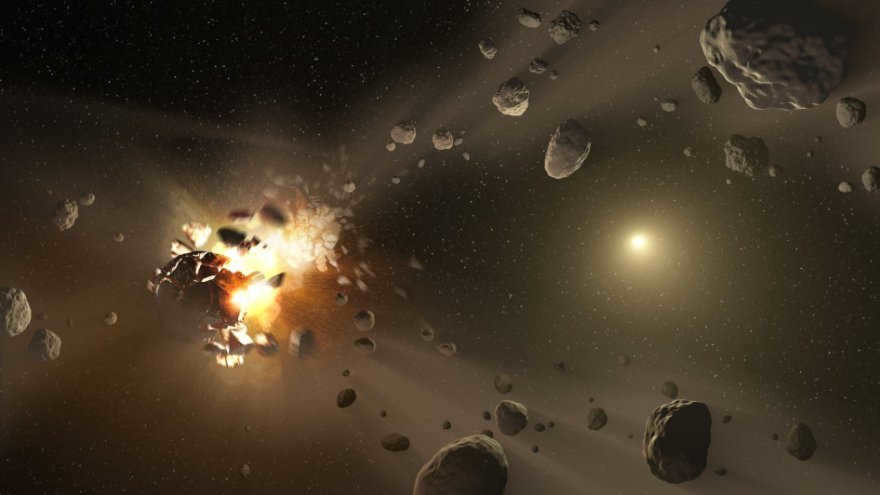

The artistic concept of asteroid family formation
Among the most well-known families in the asteroid belt are the Flora, Eunoma, Koronis, Eos, and Themis groups. The Flora family, composed of over 800 objects, is considered one of the largest and may have formed from an ancient impact billions of years ago. This family is located in the inner region of the asteroid belt and consists mainly of S-type asteroids, which make up about 4-5% of the total number of asteroids.
The Eunoma family is known for its collection of S-type asteroids and is named after the goddess of law and order. These asteroids are found in the intermediate belt and account for about 5% of all asteroids. The Koronis family is home to around 300 asteroids, with the largest being 208 Lacrimosa, which measures approximately 41 km in diameter.
The Eos family is located at a distance of 2.96-3.03 astronomical units and emerged following a collision approximately 1-2 billion years in the past. It encompasses 4400 individuals that bear a resemblance to the S-type. However, infrared analysis reveals distinct variations, leading to their classification in a separate category known as K.
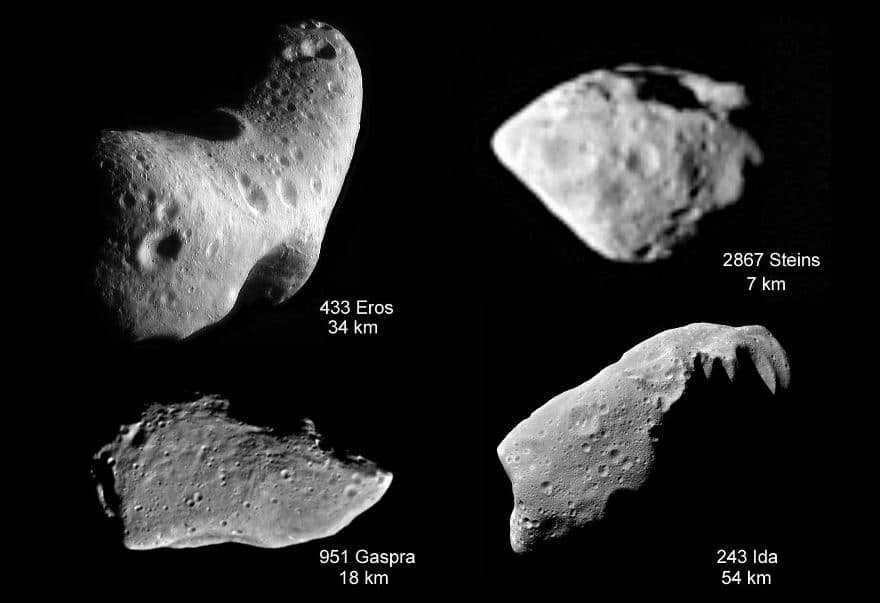
Asteroids that have been observed display surfaces that resemble craters.
The group known as Themis is situated in the outer region of the asteroid belt, approximately 3.13 astronomical units away. Of particular interest are the 24 Themis objects that belong to the C-type. The largest of these objects is Vesta, and the Themis family was formed as a result of collisions.
Within the asteroid belt, it is also possible to find lines of dust particles with radii ranging up to several hundred micrometers. These fine particles are a result of asteroid collisions. There are three lines with similar orbital inclinations.
How the Asteroid Belt Formed
The origin of the asteroid belt has long been a subject of debate among scientists. Initially, it was believed that the belt formed as a result of the destruction of a massive planet that once existed between Mars and Jupiter. This hypothesis was put forth by G. Olbders and W. Herschel. However, further research and observations led to the rejection of this theory.
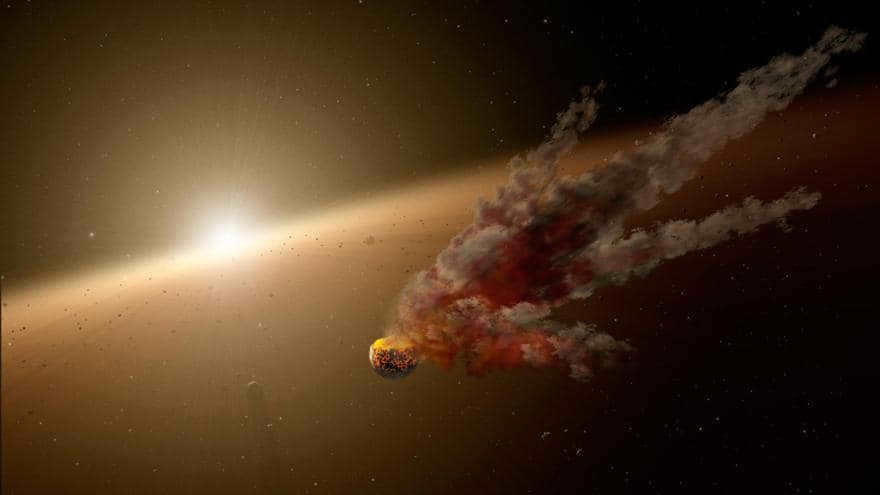
An artistic representation of the early solar system, where particles colliding in the accretion disk led to the creation of planetesimals.
To begin with, the destruction of a planet would require an immense amount of energy. Additionally, it is worth noting that asteroids, which make up only 4% of the lunar volume, have varying chemical compositions.
The current conclusion is that asteroids serve as remnants of the early solar system and were never part of the planet. During the initial million years, when gravitational accretion triggered planet formation, clusters of matter merged into substantial entities. However, within the asteroid belt, planetesimals were overpowered by Jupiter’s formidable gravity and failed to merge.
However, do not view asteroids as the primary material of the system. They have undergone an extensive evolutionary phase, including internal heating, surface melting from collisions, and cosmic weathering. As a result, the modern belt only contains a small fraction of the original mass.
According to computer simulations, the initial size of the mass was similar to that of Earth. As a result of gravitational disturbances, the majority of it was expelled one million years after its formation. At the time the first asteroid formed, the temperature at a distance of 2.7 a.u. from the Sun matched the location of the “snow line” (where water freezes).
Exploring the Asteroid Belt
Space is filled with a multitude of asteroids, making it necessary for spacecraft to navigate through the asteroid belt that lies between Mars and Jupiter. Remarkably, the chances of a collision occurring during this journey are extremely low, with a probability of just 1 in a billion.
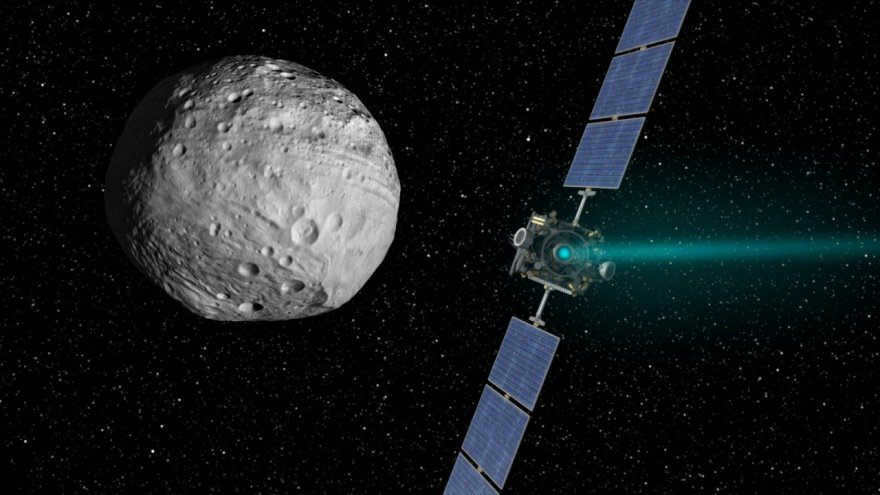
The spacecraft known as Dawn has successfully reached its destination of the asteroid Vesta.
Pioneer 10 was the first spacecraft to navigate through the asteroid belt in 1972 en route to Jupiter. Concerns were raised at the time about potential damage from debris, but the mission, along with subsequent ones such as Voyagers 1 and 2, Ullis, Galileo, NEAR, Cassini, Stardust, New Horizons, Rosetta, and Dawn, proved to be successful.
The primary objective of these missions was to explore the outer solar system and its various celestial bodies. Specifically, Dawn, NEAR, and Hayabusa were focused on studying asteroids. In 2011-2012, Dawn completed its journey to Vesta and is now on its way to Ceres.

